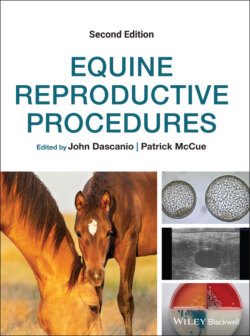Читать книгу Equine Reproductive Procedures - Группа авторов - Страница 46
White Blood Cells
ОглавлениеNeutrophils are the predominant white blood cells (WBCs) identified on uterine cytology preparations (Figure 17.3). Neutrophils are 10–12 μm in diameter (about twice as large as a red blood cell (RBC)), with a single nucleus that may be indented or divided into 3–5 lobes or segments.
A cytology sample collected from a normal mare in estrus should have very few or no neutrophils; however, a rare neutrophil may be noted in association with blood contamination that occurred during the collection process. Neutrophils may be present in the uterine lumen following breeding, after uterine lavage or infusion, during the postpartum period, or in cases of endometritis.
Other WBCs such as macrophages, lymphocytes, or eosinophils are not commonly found on equine uterine cytology preparations.
Lymphocytes are approximately 7 μm in diameter (the same size as RBCs), are round to oval, and have only a small amount of cytoplasm (Figure 17.4).
Macrophages are approximately 20 μm in diameter with abundant blue‐staining cytoplasm filled with various‐sized vacuoles (Figure 17.5). Lymphocytes and macrophages are found in in the postpartum mare and in chronic uterine infections.
Eosinophils are 12–15 μm in diameter, with blue‐staining cytoplasm that contains multiple pink or red granules (Figure 17.6). Eosinophils are found in cases of pneumovagina, fungal infections, or reflux of urine into the uterus.
The average number of WBCs per high power field (hpf) is determined after evaluating at least 10 hpf in multiple areas of the slide, and is used to categorize the degree of inflammation (Table 17.1).
Another method used to categorize the inflammatory response is the number of WBCs per UEC. A ratio of 1 WBC to 20–40 epithelial cells has been used as a gauge of the degree of inflammation.Figure 17.3 Inflammatory uterine cytology with quiescent macrophage (large arrow) and many neutrophils (small arrow).Figure 17.4 A lymphocyte (arrow) in a uterine cytology sample.Figure 17.5 A pair of macrophages (solid arrows) in a uterine cytology sample along with neutrophils (open arrow) and red blood cells (arrow head).Figure 17.6 An eosinophil (arrow) in a uterine cytology sample along with neutrophils and a red blood cell.Table 17.1 Description of the number of neutrophils per hpf with corresponding inflammation classification for samples collected from a brush/swab.Number of Neutrophils per hpfClassification0 to rareNormal1–2Mild inflammation3–5Moderate inflammation>5Severe inflammation
Categorizing the degree of inflammation represented in a cytologic sample from a low volume lavage can be difficult. Centrifugation of the uterine effluent concentrates UECs, WBCs, microbial organisms, and debris into a pellet. The pellet is subsequently smeared onto a glass slide, stained and evaluated. A normal mare should have very few or no WBCs noted in the cytology from a low volume lavage. Mares with mild uterine inflammation often have >5–10 neutrophils per hpf, whereas mares with more severe inflammation usually have >10 neutrophils per hpf. The presence of microbial organisms should be interpreted with caution, as there is a higher risk potential for contamination during sample collection with a low volume lavage procedure versus the use of a double‐guarded uterine swab or brush.
